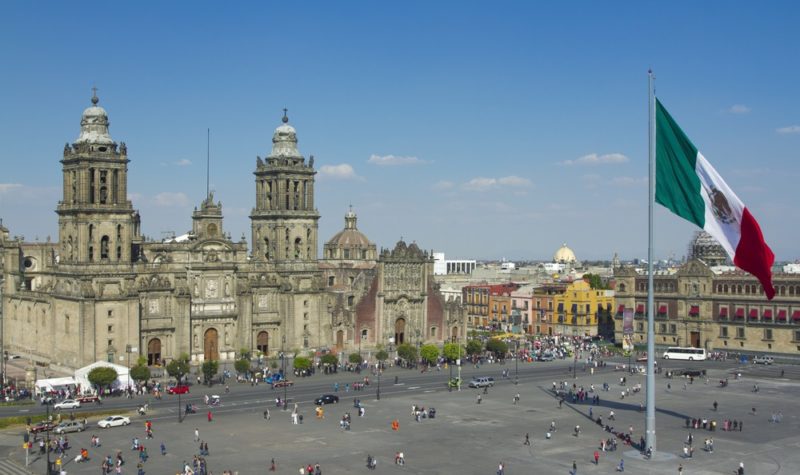Is this country the ultimate contrarian bet?

There are plenty of financial forecasts knocking around at this time of year, but the most entertaining are the 10 deliberately outrageous predictions from Saxo Bank. These are intended to flag up the outlier events with the most potential to move the markets. You can read them all here.
The one that caught my eye was number eight on the list: “Despite Trump, the Mexican peso soars – The market has drastically overestimated Donald Trump’s true intention or even ability to crack down on trade with Mexico, allowing the beaten-down peso to surge.”
This is probably the ultimate contrarian bet given Trump’s fierce anti Mexican stance, which he first made public in June 2015 when he announced his candidacy for the presidency: “I would build a great wall, and nobody builds walls better than me, believe me, and I’ll build them very inexpensively. I will build a great, great wall on our southern border. And I will have Mexico pay for that wall.”
“Build that wall,” became one of his most controversial slogans, so it is no surprise that the Mexican peso has taken a real hammering since the election. Between the eighth of November and December nineteenth the currency fell by 11.5% against the US dollar and by about 12.5% against the pound.
Investors are nervous
Investors in Mexico are nervous about the impact of Trump’s protectionist policies including his promise to renegotiate the North American Free Trade Agreement (NAFTA). This has undermined consumer and business confidence and could result in lower household consumption and investment. If the new president imposes trade barriers between the two countries it could have a dramatic effect on the Mexican economy due to the close ties between them.
Analysts from the US bank, Wells Fargo, have recently forecast that the Mexican economy will experience a mild recession in 2017 with GDP falling by 1.1% in real terms, although they acknowledge that President Trump’s policies are still a complete unknown.
In their report they said: “Mexico is different because President-elect Trump started his US presidential campaign arguing his case to stop illegal immigration from Mexico, deport 11 million illegal immigrants from that country, build a wall to prevent Mexicans crossing north in the future and renegotiate or even end the NAFTA free trade agreement. Thus, even if only part of these promises become a reality, the effects on the Mexican economy are going to be noteworthy.”
The US accounts for around 80% of Mexico’s exports, almost half of its imports and about 60% of its foreign direct investment.
The US accounts for around 80% of Mexico’s exports, almost half of its imports and about 60% of its foreign direct investment. In fact Mexico recently became the second largest exporter to America after China. The main reason for this is the cheap labour costs – the minimum wage is less than $4 a day – that have tempted companies to set up in Mexico and then ship their goods over the border to sell to the US domestic market.
Mexico has been looking at ways to reduce its dependence on the US and has recently pledged to strengthen its ties with China following a diplomatic visit earlier this month. China is another country that has started badly with Trump so the move could further ignite the situation when the new president finally takes office.
Mexican funds suffer
I haven’t been able to find a London-listed ETF linked to the peso, but there are several Mexican equity ETFs and they have all suffered a sharp sell-off. The db x-trackers MSCI Mexico TRN Index ETF (XMEX) is down 15% since the US election and so too is the HSBC MSCI Mexico Capped ETF (HMEX) and the iShares MSCI Mexico Capped UCITS ETF (CMX1).
XMEX has ongoing charges of 0.65% and assets under management of $104.6m. It uses full replication to track an index that is designed to represent 85% of the readily available shares in each industry sector in the Mexican market.
HMEX is much smaller with just $11.4m of assets and provides exposure to a concentrated cap weighted index of 29 Mexican stocks. CMX1 is about seven times bigger and follows a similar benchmark with both using full replication to match the returns.
Investors who decided to take a punt on Trump would have been well rewarded if they had used the ProShares UltraShort MSCI Mexico Capped IMI ETF (SMK). This aims to generate two times the inverse daily performance of the MSCI Mexico IMI 25/50 index and is up 34% since the US election.
Despite the sell-off the 27 large caps in the MSCI Mexico universe still seem pretty expensive with the index yielding 1.88% and trading on a forward PE ratio of 17 times earnings at the end of November. Over the first eleven months of the year the benchmark was down just under 10%.
Politicians often fail to live up to the hype, so if Trump finds that the political reality of life in the White House is a lot more challenging than making up policies on Twitter we could see a sizeable rebound in the Mexican ETFs. This could make them the ultimate contrarian bet, but if you expect him to deliver you would be better off sticking to the double short fund that trades under the ticker SMK. Either way it should be an interesting New Year.
Comments (0)